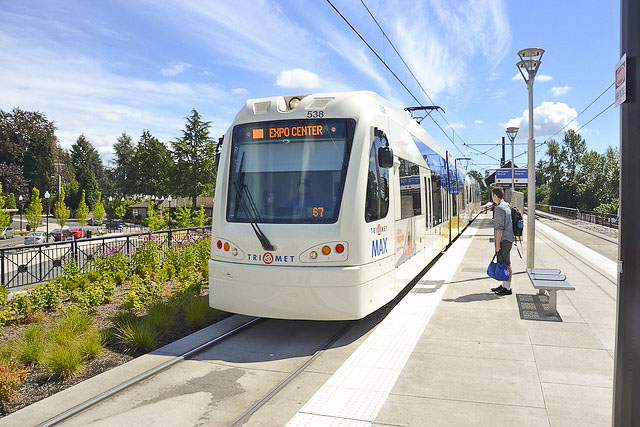TriMet will not cover O&M costs of MAX in Washington state
John Ley
for Clark County Today
A TriMet official has admitted that new taxes will be required to pay for the Operations and Maintenance (O&M) costs of light rail being extended into Vancouver as part of the Interstate Bridge Replacement Program (IBR). The official further expects the capital costs to build the three-mile light rail extension into Clark County will be between $1 billion and $1.3 billion. The new taxes will have to come from both sides of the Columbia River.
At the June 17 meeting of the Bi-state Bridge Committee of 16 Oregon and Washington legislators, TriMet’s JC Vannatta, executive director of Public Affairs, said TriMet would not cover O&M costs for the portion of light rail in Vancouver. “We don’t have detailed cost estimates or cost sharing plans yet,” he said. “This too will be a critical element of the project’s next phase.”
“Currently, as the project has probably told all of you that conceptual capital costs for the entire IBR program is $3.2 to $4.8 billion,” he said. “This includes about $1 billion to $1.3 billion associated with the transit elements.”
Vannatta expects updated cost estimates to build the MAX extension should be available by early 2023. Yet the IBR team members are asking legislators and key “partners” around the region to approve their recommended alternative with light rail next month.

The option not being advanced for high capacity transit is C-TRAN’s Bus Rapid Transit (BRT). C-TRAN is presently building its second BRT line along Mill Plain. This 10-mile extension will cost about $50 million, less than 4 percent of a $1.3 billion three-mile light rail extension. C-TRAN has not asked for new taxes to cover O&M costs for any of its lines in the BRT system.
In the failed Columbia River Crossing, light rail construction accounted for $825 million of the $3.5 billion cost, according to forensic accountant Tiffany Couch.. A possible $450 million increase is over 50 percent more. None of the operating costs are covered by the federal government.
Economist Joe Cortright shared the following via email. “Neither C-TRAN nor TriMet is willing to commit any funds of their own to this project. This is especially important because the USDOT (Federal Transit Administration) won’t fund the capital construction of a project that has no source of operating funds.
“TriMet’s board considered their endorsement of the project last Wednesday. They voted to go ahead, provided somebody else pays for its entire costs.”
Operations and Maintenance costs sharing
During their Wednesday Council Time discussion, members of the Clark County Council discussed the IBR’s recommended proposal. They will hold additional discussion on a summary paper introduced by Chair Karen Bowerman next week, and hope to hold a hearing and vote on the matter at the July 19 regular council meeting. The paper was titled “Refocusing the I-5 Bridge Replacement.”
The issue of additional taxes came up and Councilor Temple Lentz assured her fellow councilors that the C-TRAN Board of Directors had been very explicit in opposing new taxes or having Clark County residents paying for Portland’s light rail.
“I know that absolutely, the management of C-TRAN feels very differently, and is prepared to lead that charge defending Clark County taxpayers,” she said. Lentz recommended language that joins in the effort to oppose new taxes and “keeps us more relevant in the conversation” about the IBR.
Yet TriMet won’t pay for light rail into Vancouver. “You should know some key agreed upon assumptions among partners, include that TriMet will operate and maintain the light rail vehicles systems electrification track for the entire LRT extension, plus the stations and other improvements in Oregon,” Vannatta said. “TriMet will not be responsible for O&M costs resulting from the extension into Vancouver.”
This should come as a surprise that the “partners” have agreed upon certain assumptions about cost sharing. There was no mention of this agreement at the June C-TRAN Board of Directors meeting just three days prior.
TriMet’s JC Vannatta explains to the Bi-State Bridge Committee of 16 Oregon and Washington legislators that they will not cover the operations and maintenance costs of light rail in Vancouver. He indicates new revenues (taxes) will be needed to cover the O&M costs and both TriMet and C-TRAN will work to identify those new revenues for the MAX extension into Vancouver. Video courtesy Interstate Bridge Replacement Program
Five days after legislators met, the TriMet Board of Directors approved “a number of significant conditions that must be satisfactorily addressed prior to Program completion.” Those conditions included the 2013 significant expansion of the TriMet Ruby Junction facility in Gresham, an upgrade to Portland’s Steel Bridge, and questions regarding the proposed Vancouver waterfront light rail station.
One news report at the time indicated the requested funds were five to six times previous light rail expansions. Acuity Forensics issued a 12-page white paper analysis of the Ruby Junction and Steel Bridge expenditures as part of the failed Columbia River Crossing (CRC).
“Forensic accountant Tiffany Couch has found $50.6 million is budgeted for TriMet’s Ruby Junction light-rail maintenance facility, 16 miles from the CRC site. The reason? So Ruby Junction can handle 19 additional light-rail cars for a new Vancouver line. Couch notes the Milwaukie MAX expansion will add 20 cars but only includes $8.1 million for Ruby Junction. Couch called the CRC money padded on for TriMet’s facility significant enough to be classified as an irregularity.”
The present proposal is using the exact same Purpose and Need statement as the CRC, which defines the problem to be solved. The only cost estimates provided are updated based on the failed CRC design, which included light rail. However the $3.5 billion CRC included a great deal of spending outside the five-mile bridge influence area. This included money for a new TriMet headquarters building and funds for a project in Hood River in addition to the Steel Bridge and Ruby Junction improvements.
Currently, C-TRAN passenger fares cover 5.9 percent of operating costs. Taxpayers are picking up the 94 percent balance through the sales tax. Pre pandemic, taxpayers were picking up 86 percent of operating costs at C-TRAN.
For TriMet, passenger fares only covered 5.5 percent of operating costs in 2021. Payroll and other taxes accounted for 52 percent of revenues, along with grants making up 41 percent of revenues. A year earlier, passenger fares covered 12.6 percent of operating costs.
On Thursday, Bowerman shared the following on social media.

“The issue with light rail being featured in the Interstate Bridge Replacement project’s ‘Modified Locally Preferred Alternative’ is getting more interesting every day. The latest is from a TriMet June 22 resolution authorizing approval of the modified locally preferred alternative of the IBRP and stating ‘TriMet will operate and maintain the vehicles, systems, electrification, and track of entire the LRT, and the station areas and other improvements located in Oregon. TriMet will not be responsible for any LRT operations and maintenance costs resulting from the extension into Vancouver.’
“Really? It has been said that light rail costs for Clark County will exceed $1 billion, and the state of Washington has already committed $1 Billion to the I-5 bridge replacement. Since TriMet is not responsible for any light rail O&M costs in Vancouver, who will pay for that? As chair of the Clark County Council, I will not support our taxpayer funds being used to cover for TriMet light rail expenses that stop in Oregon!”
Also read:
- Opinion: Hiding the growing cost of the Interstate Bridge replacementJoe Cortright of the City Observatory addresses the rising cost of the Interstate 5 Bridge replacement project.
- 90 minutes of delay on Southbound I-5 in Southwest Washington on Friday afternoon, July 26Travelers using southbound Interstate 5 through Woodland should expect up to 90 minutes of delay during Friday afternoon and evening and should delay travel or prepare for additional travel time.
- Nighttime paving work on I-5 and SR 14 in Clark County July 28-Aug. 9Nighttime travelers in Clark County should expect delays for maintenance and paving work beginning Sunday, July 28 until the morning of Friday, Aug. 9.
- Northeast 182nd Avenue/Northeast Ward Road to be closed on Aug. 1Northeast 182nd Avenue and Northeast 172nd Avenue in Clark County will have single-day closures on August 1 and August 5 for road preservation, with detours in place.
- Interstate Bridge Replacement program awarded $1.499 billion FHWA Bridge Investment Program grantInterstate Bridge Replacement program officials have shared that the program received $1.499 billion through the Federal Highway Administration’s Bridge Investment Program.









